ARE SPORTS INFLATION/ RECESSION PROOF?

REASONS FOR CONCERN AND OPTIMISM IN 2023
RETAIL HOUSEKEEPING FOR THE NEW YEAR GEARING UP FOR HOCKEY WEEK ACROSS AMERICA


REASONS FOR CONCERN AND OPTIMISM IN 2023
RETAIL HOUSEKEEPING FOR THE NEW YEAR GEARING UP FOR HOCKEY WEEK ACROSS AMERICA
NECK AND ARM BINDING FOR ADDITIONAL DURABILITY AND COMFORT

REVERSIBLE DESIGN THAT IS PERFECT FOR BOTH PRACTICE AND GAMES
FULLY CUSTOMIZABLE AND REVERSIBLE SHORTS



Some of the contract signings from the baseball winter meetings in early December reinforce that the owners and players are operating in a financial stratosphere the rest of us could only reach with a winning Powerball lottery ticket. For the rest of us, inflationary pressure is a real concern.
Thankfully gas prices were dropping in early December, but higher food prices and rising utility bills add pressure. Most of the “regular public” felt the financial pinch of inflation in 2022 and have concerns about a recession as 2023 begins.
When it comes to sports at the youth levels there is a common belief they are recession or inflation proof. One where parents will make significant sacrifices so their kids can play the games they love. That was the feeling when the U.S. economy went into a recession 15 years ago.
There are a few differences this time around. We are still only three years removed from the start of the COVID-19 pandemic that forced kids off fields and courts for extended periods of time. There is an increased emphasis on much costlier travel, club and so-called “elite” competition and specialization at younger and younger ages where kids should be trying as many sports as they can.
What happens to kids whose families are wondering where they must draw the bottom line? Let’s look at baseball and ice hockey and the NSGA participation numbers in households with a yearly income of $100,000 or more. These are sports where the parents invest in costly equipment in addition to the fees to play. Ice hockey shows 46.5% and baseball 45.5% of participants from six-figure income families. More than half of the participants in those sports are from families facing
greater financial constraints. As a sidenote, this emphasizes the need to support legislation like the Personal Health Investment Today (PHIT) bill, which offers some tax relief for these sports-related expenses.
Another sport which requires a significant investment is lacrosse with 54% of participants in the $100,000 and up family income bracket. It’s not surprising to see sports such as tennis (55.4%), golf (55.9%), ice/figure skating (56.6%) and alpine skiing (64.9%) above the 55% mark in the six-figure category. Will we see participation and purchases sustained in these activities because families making more than $100,000 were less affected by inflation?
Theoretically, those sports and activities supported by higher income families will be less affected. Likewise, those sports and activities which reflect lower family income participants may experience greater financial pressure. However it shakes out, my prediction is most price increases affecting sports equipment, apparel and shoe customers are here to stay, and most consumers reluctantly accept that new reality.
Most of the retailers and dealers we have talked with say they were having record years in 2022. Some of them also cautiously wonder how long this will last and they were already seeing some slowdowns in sales as the year ended. It forces retailers and dealers to carefully consider their local and regional environment and the sports and activities they sell. One answer does not apply to all situations.
CHAIRMAN OF THE BOARD
PAT DONNELLEY
BSN Sports, Twin Falls, ID
PAST CHAIRMAN
DAVID LABBE
Kittery Trading Post, Kittery, ME
BOARD OF DIRECTORS
KEVIN BEZANSON
Cleve’s Source for Sports, Halifax, Nova Scotia, Canada
BOB FAWLEY
Capitol Varsity Sports, Oxford, OH
TROY FREEMAN
Play It Again Sports, Minneapolis, MN
GORDON GEIGER
Geiger’s, Lakewood, OH
MICK MONTGOMERY

Denver Athletic Supply, Englewood, CO
RON RUGAL
B&R Sporting Goods, Shelby
Charter Township, MI
JOHN SCIPIO
SV Sports, Pottstown, PA
NSGA TEAM LEADERS
MATT CARLSON
President & CEO
MARTY MACIASZEK
Director, Team Dealer Division, Communications
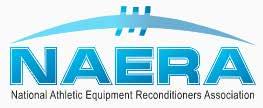
JULIE PITTS
Director, Public Affairs and President, NSSRA
NICK RIGITANO
Director, Insights and Analysis
JENNIFER SHAFFER Comptroller
Best regards,
MATT CARLSON PRESIDENT & CEOSuite
Downers
60515. Phone: (847) 296-NSGA (6742); Fax: (847) 391-9827. Subscription price of $50 per year is included in membership fee. Non-member subscription information available from publisher. Periodical postage paid at Downers Grove, IL 60515 and additional mailing offices. POSTMASTER: Send address changes to NSGA NOW,® 3041 Woodcreek Drive, Suite 210, Downers Grove, IL 60515. © NSGA 2023 all rights reserved. Printed in the USA.

Albert Patrick “Pat” Johannsen, who was a member of the NSGA Board of Directors from 1998-2004, passed away Nov. 8, 2022 at 75. Johannsen founded Johannsen’s Sporting Goods in 1969 in his lifelong residence of Augusta, Georgia.

Johannsen was an active member of the Augusta Country Club and served on the Board of Governors and as Chairman of the Golf Committee. He was also president of the booster club of Aquinas High School, his alma mater. The opportunity to serve the local athletic community led to him starting Johannsen’s Sporting Goods and becoming a staple in the Augusta business community.
Johannsen is survived by his wife Cheryl, five children and five grandchildren.
Phil Blair Johnson, the second of four generations of family to be involved with Johnson-Lambe, passed away Nov. 20, 2022 at 88 in Raleigh, North Carolina. When Johnson graduated from North Carolina he joined his dad and business founder Rochelle “Red” Johnson in the daily operations of Johnson-Lambe.
Phil Johnson is credited with using his business acumen to keep the store successful by pivoting to match the evolving demands of the sporting goods industry. Phil’s son Rhett is the president of JohnsonLambe and Phil’s grandsons Cole and Grey also work for the business.
Phil Johnson is survived by his wife Emily, four children, seven grandchildren and one great grandchild.
Red Johnson, left, and Phil Johnson at Johnson-Lambe Sporting Goods in Raleigh, North CarolinaWith 2022 now in the rearview mirror, it is time to reflect on what worked well and what needs improvement in the coming year. Consider the following guideline for housekeeping items as you begin 2023:



Make this priority No. 1. Without good physical, mental and financial health nothing else really matters. If you can’t take care of your own health, taking
care of your business health is going to be difficult, if not impossible. Staying healthy involves proper nutrition, exercising regularly and getting plenty of rest. This sounds basic and perhaps even trite, but you would be surprised by the number of store owners who don’t take care of their health and pay a hefty price as a result.
Is your business financially fit? Now is the time to assess your financial health. Are you cash-flow positive? If so, did you plan to be that way or did you get lucky? Lady Luck can be fickle and turn against you quickly. Doing a cash-flow plan regularly is a simple exercise that can quickly reveal where potential problems exist. If you do not have a good cash-flow form, feel free to contact me for one.
One warning: In most cases, if you continually use current season sales to pay the previous season’s invoices, you have a problem!
Most of us get so wrapped up in solving immediate problems (aka, putting out the small fires) that we do very little long-term planning. I bet many of you will spend more time planning your vacation than you gave thought to the first quarter of 2023, let alone two to three years from now.
Mike Alic, Management One President, summed it up perfectly by saying, “If you don’t lay the foundation for the next big thing in your business today, you won’t be ready to make the move tomorrow.” Examples that require longterm planning might include a remodel, a new space, adding another location, a new POS system, overhaul of your website or a major shift in personnel, to name a few. What long-term projects are you currently planning?
January is the absolute best time of the year to review the year-end profit and loss statement. This document is too critical to your ultimate success to be simply filed away. You should have industry benchmarks for all major expense categories as well as initial markup and margin expectations. You
will want to make sure your year-end results are in line with industry averages and there is a sufficient spread between gross margin and total expenses. If you are not comfortable reading this statement or how to interpret its results, we can easily show you in 5 minutes. All you have to do is reach out.
When it comes to reviewing inventory, there are several considerations at year-end. Reviewing the existing class structure is a logical starting point. Does the current category hierarchy fit your existing business? I review class structures regularly for stores. What I typically find is they rarely change. It is not uncommon to find classifications in a system that has had very little if any activity for years in some cases. These should be eliminated.

On the other hand, sometimes a category or class has grown to the point that the data provided is so cumbersome the information is of little value. This would be an example of a class that should be broken down into smaller, more controllable sub-classes. Planning at a smaller level allows the merchant to make better buying decisions and identify potential problems more quickly. If you have taken a year-end physical inventory, January is a good time to reconcile the inventory. Make certain you know where and why shrinkage problems exist. Without this knowledge, you can’t address the problem. It is also a good time to review any procedures related to inventory accuracy. This could include transfers between stores, receiving practices, how customer returns and vendor returns are handled and if markdowns are being recorded properly.
Now that the year is complete, the current resource matrix should be evaluated. If you are a store that finds itself overbought often, perhaps you
are carrying too many vendors. This can also lead to duplications in assortment, which is a major contributor to profit-eating markdowns. Supply chain disruptions, customer service and shipping accuracy need to be taken into account. Use a vendor scorecard that takes into consideration not only sales, but margin and ROI (return on investment). This is an excellent tool for vendor negotiations if needed.
Another important area to review is current staffing needs. Do you have the right people in the right seats on the bus, as Jim Collins describes in his
management book, Good to Great? A great employee will not help the organization in the best way possible if his or her talents are not utilized effectively. Good sales associates do not necessarily make good managers and good buyers don’t always make good merchandise managers. All these positions require completely different skill sets.
The points just provided make a good template to begin planning for 2023. Any of these topics would provide excellent material for management meetings. By reviewing these six major areas and implementing any needed changes, you can set up 2023 to be a banner year.
Sayner has spent the past four decades helping independent retailers improve profitability. In addition to speaking to retail groups nationwide, Sayner is a regular contributor to retail industry publications. Prior to embarking on his retail consulting career, he was the general merchandise manager for an independent department store in the Midwest. Ritchie is a graduate of the University of WisconsinLaCrosse. He is also the author of the book, “Retail Revelations-Strategies for Improving Sales, Margins, and Turnover.” He can be reached though his website at www.advancedretailstrategies.com. @RitchieSayner




Submissions accepted until MARCH 31, 2023
Nominate a deserving individual for the 2024 Class of the Sporting Goods Industry Hall of Fame


Learn more and nominate at nsga.org/hall-of-fame/

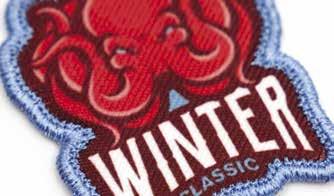



Add value to your decoration with professional, high-end, dimensional looks. Using premium transfers, set yourself apart from the competition and provide your customers more.
Easily bundle uniform orders with hard goods like tumblers and water bottles to offer the ultimate sports packages! Make your business the MVP of custom sports branding with emblems and patches.



BAWCUM: I would say sports as a whole and even the sporting goods industry are immune to inflations/recessions. That is not to say some companies may suffer during these times if they are not prepared or operate on very thin margins. If you look at the household level during these times, sports programs for kids up through high school are almost seen as a necessary household expense, like school. You may see school budgets drop during these times; however, parents and the booster clubs often pick up the slack through fundraising to make sure teams have everything they need.
When we started Trigon Sports in 2007, we were smack in the middle of a huge recession. Although this was a risky move on our part, we found that our business thrived. This was due, in part, to school sports programs finding funding no matter what and ordering from our team dealers, which, in turn, brought profits up to the manufacturers and distributors.
RACHELLE MANNING
CHANNEL MANAGER –SPORTING GOODS
SANMAR SPORTS
ISSAQUAH, WASHINGTON
DUSTY RHODES
CAREY: I thought for many years the team side of the business as a whole was recession-proof. But with the COVID pandemic I found that not to be true. I think the Southern states weren’t affected as much because we seemed to muddle through the situation a little better than most. Still it created problems for us all in one way or another.

HAUFF: I think that question varies within our country. During a previous recession, we in South Dakota and Nebraska did not participate in the recession. Schools receive their funding from taxation, so as the value of property increases, so do one’s taxes. So, school funding increases based on the taxes collected in a county or district.

Non-school programs may have a more difficult time raising funds based on corporate advertising/donations. When a recession occurs, corporate sales in our company slow down, but do not quit since some industries are not affected by a slowdown of the economy. Parents find a way to help fund programs for their children.
I think inflation affects more schools than does recession. We have noticed the shock factor of the inflation in many clients — “you mean I paid $10 for a product last year and now it is $15 this year?” We are not sure if budgeting will be affected for the 2023–24 school year as we are working with schools to format their budgets now. We will see what happens to our sales for the next school year.
MANNING: Historically the sporting goods channel has been relatively recession-proof. Families will forgo that family vacation to allow their kids to play a sport if money is tight. They may buy the glove this year and not the bat until next year. But the industry hasn’t experienced a significant decline.
Where I’m not sure is if prices keep rising, do people trade down? Instead of the expensive new “X,” do I buy a mid-tier “X” instead. We still might sell the same unit volume, but at lower overall revenues if people are feeling squeezed. SanMar Sports can have a big impact if consumers choose to “trade down.” We have a large non-branded and aggressively priced assortment of apparel, bags and hats.
RHODES: It depends on the type and scope of the recession, right? The industry is definitely vulnerable, albeit less than other industries. When customers have limited funds it will ultimately be about value and quality.
 Sporting Goods Association panel of retailers/team dealers and suppliers shares their perspective in this Q&A.
Sporting Goods Association panel of retailers/team dealers and suppliers shares their perspective in this Q&A.
BAWCUM: High inventory levels and rising shipping costs are a big concern. The pandemic shutdown really did a number on our industry supply chain and many companies suffered. Other companies reacted by buying heavier to fulfill the backlog and consequently, have a surplus on hand to meet demand. Now with the container prices back at pre-pandemic levels, many companies are taking full advantage of the lower costs and still buying heavy. Domestic truck freight costs are steadily increasing, especially with high diesel fuel costs. It is my hope that the lower container prices may help offset the higher domestic shipping costs so there are no adverse pricing issues passed down to our customers.
CAREY: I’m very concerned about stabilization of the hard goods side of our industry for ‘23. Even though it has improved somewhat it’s still an ongoing challenge. We have found that the “Made in the USA” companies seem to have better fill rates than those that import most of their goods. The imports are still at the mercy of shipping costs and on-time deliveries.
HAUFF: We hope that deliveries get closer to previous commitments. We are working with vendors that have taken care of our company during this two-year disruption in the markets. Our staff hopes to quote our clients for budgeting purposes one day and not have to requote them with increased prices as it gets closer to the purchase.
We are hoping for price stabilization in the industry. Most of our vendors honored the orders we placed in November 2021 for deliveries in 2022, but there were two vendors who increased the prices on our purchase order. We ate the increase as we did not go back to the customer with an increase. A contract is a contract and we held up our side of the agreement.
MANNING: My biggest concern isn’t sales to the players on the teams, it’s sales to all the “extras.” That extra practice shirt, the travel suits, etc. People in the stands and faculty, boosters, etc., may choose to wear last season’s product, not the “new” team’s for this season. Recession and decrease in consumer spending could mean fewer fans are buying that team hoodie or hat to show their support. However, this also benefits the non-branded suppliers like SanMar Sports. We provide an exceptional value for when the industry is searching to reduce spending.
RHODES: Inflation is huge for sure. But I think every year it is about being more innovative and improving relationships. How can a company in our industry solve the pain points and needs of our customers? If we do a great job in that area we’ll be just fine.
BAWCUM: Import costs are returning to pre-pandemic levels, which is fantastic for our industry and customers. It appears manufacturing and raw material costs are becoming more stable, so, hopefully, we can get back to more stable pricing for our dealers instead of the constant price fluctuations we have seen over the past few years. If you talk to most dealers and manufacturers, most had a fantastic 2022 fiscally, and I feel this trend will continue into 2023 despite the recession that looms. Sports will be played and these teams will need product. It’s a good thing our industry will have a beefier inventory now to take care of any demand that might come.
CAREY: Uncertain times create a tougher, more creative way of doing business. After getting back from our last Sports Inc. show I feel a positive sense of resolve from both dealers and manufacturers. We have all been paddling upriver since COVID. But I think with the continued efforts of our industry we will reach the other side sooner than later.
HAUFF: I think deliveries will be more reasonable in 2023 as vendors are receiving product quicker than in 2020 and early 2021. There is not the huge container problem now. We are hoping for price stability now. I think a lot of the problems of the supply chains have eased which will help the vendors deliver orders. Also, I think our vendors have consolidated their product offerings and will do a better job of stocking merchandise. We as a company will order more product for inventory so we eliminate the price changes that occur during a season. We experienced a sellthrough on inflatable products this year so we had to increase our pricing at the beginning of the sports season. Those schools that ordered early benefited from our purchase plans, but our backup inventory was not good. We have a positive staff that works hard with our clients. We visit each school regularly, work the buying shows and work with the sales reps. A positive, hard-charging staff will find a way to be successful. Our model has changed but our forward-thinking staff continues to be the best as 2022 has been a record year for Hauff Mid America Sports.
MANNING: I think our industry continues to show its value and resilience. I believe we will continue to grow our overall market by taking volume away from brick and mortar and exclusively catalog businesses. Even if things slow down, our industry has the ability to continue growing if we are creative in how we pursue opportunities. We are also growing our assortment of products. You can always find something new at www.sanmarsports.com.
RHODES: I’m a huge fan of improvement and innovation. In 2023, I’m stoked to bring to market the easiest way to take and place orders. We grow by over 50% every year ... each year we are excited to show the industry what we’ve been working on and what we know will positively impact our industry over the next year.
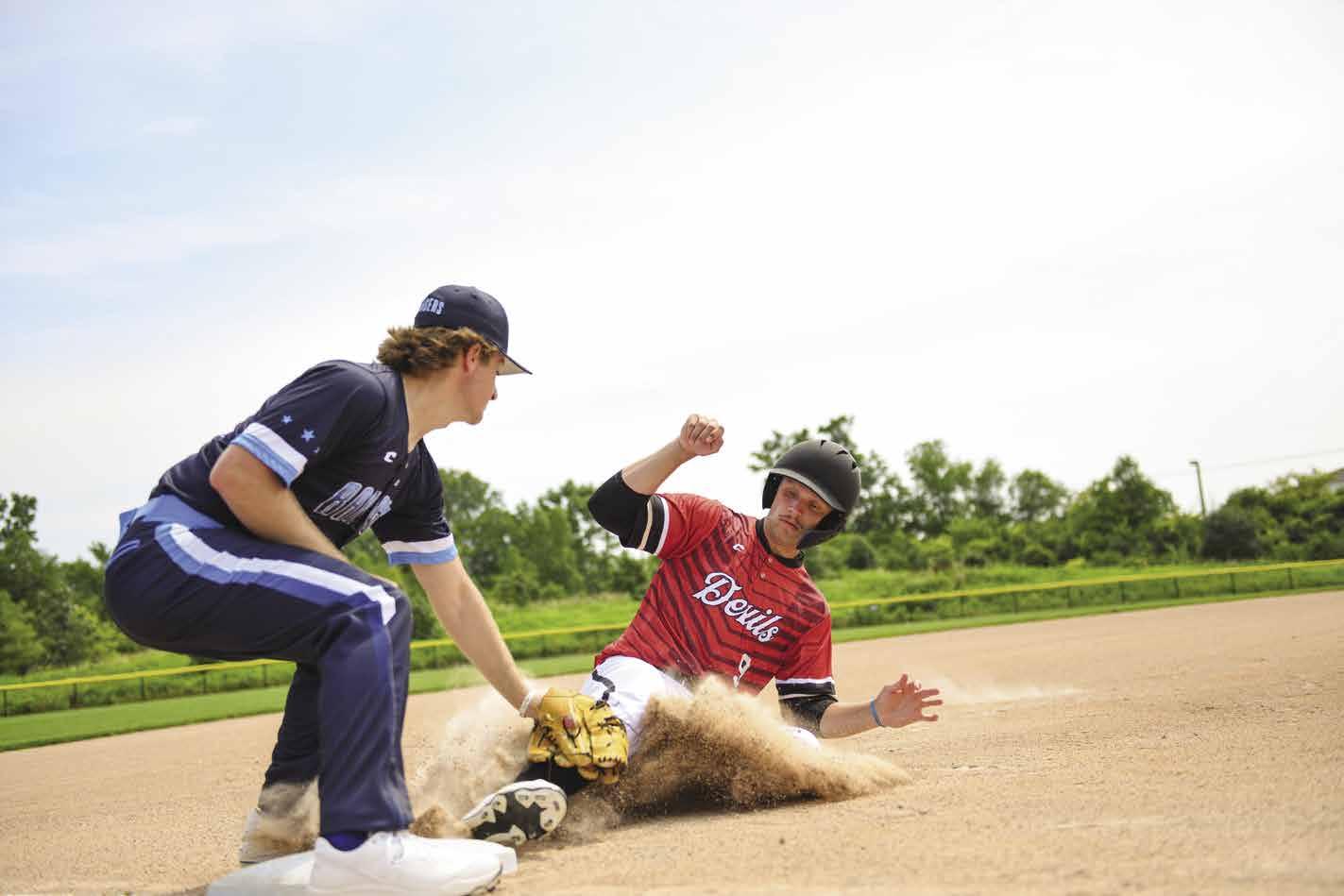



























asked some national sports organization leaders for their thoughts on sports being recession/inflation proof in 2023.
PAT KELLEHER EXECUTIVE DIRECTOR USA HOCKEY
EXECUTIVE DIRECTOR USA HOCKEY


It’s been said that youth sports are near recession-proof because parents sacrifice for their children. Regardless of whether or not that premise has merit in hockey, we need to be cognizant of the realities the economy can have on families, rink operators, manufacturers and all the partners within our industry. It’s important we strive to make hockey as affordable as possible for families. We need to be intentional about how we introduce families to our sport, then provide a welcoming and inclusive environment that allows them to fall in love with hockey at their own pace, and ultimately develop a lifelong passion for the sport.
Like all industries, the success of snow sports is impacted by macroeconomic events like recessions (see also the gas crisis and recession in the early 1990s). However, we saw that skiing and riding have become somewhat “recession-proof,” especially as that 2008–09 recession coincided with the birth of the Epic Pass. Multi-mountain passes and reduced-price season passes — and the trend of pre-season advance purchase — have helped the ski industry weather
recessions better than other industries. After the pandemic, people really wanted to get outside, and snow time is a wonderful replacement for screen time. The combination of reduced financial barriers to entry along with the prioritization of physical and mental wellness in our culture can contribute to the success of snowsports despite what’s happening on a macro level. Inflation might affect skiing and riding a little differently. During the 2020-21 season, as the U.S. was slowly creeping out of the height of the pandemic, demand for skiing persisted even as public health guidelines and local restrictions on travel and capacity made it a bit trickier to get to the slopes. Folks stayed closer to home, in many cases reducing visitation for destination resorts but increasing it for more local, drive-market ski areas. Inflation might reduce your travel or desire to buy new gear, but I think that snow sports will remain strong as skiers and riders are a dedicated bunch. Plus, a day on the hill can be an escape from the realities of everyday life, letting you breathe in fresh air and be out in nature, moving your body and sliding down the terrain of your choice.
Anecdotally, a recession might bring in new folks to mountain communities and new members to the ski area workforce. I moved to Colorado for grad school in 2008 and never left, joining the ski industry when journalism (my original planned career) was taking a big hit. My partner moved to Colorado in the early 1990s with an MBA to be a lift-op for a season until things settled down economically. He was pulled into the payroll department his first day on the job, which led to a 30-year career
in ski area finance. We learned of many young people who took a gap year during the pandemic and moved to ski towns to work at ski areas. A passion for the outdoors and a necessary change in career could develop folks into the next generation of ski-area leadersan unexpected silver lining to some of these largescale events.
MICHAEL KARONNATIONAL PRESIDENT
AMERICAN YOUTH SOCCER ORGANIZATION
In our experience, it is generally true that parents will do what they can to give their children the opportunity to participate in youth soccer programs. Their ability to accomplish this depends largely on two factors: the availability of programming that meets their lifestyle needs and the cost of soccer programs relative to other programming choices they can make.
What we’ve seen since the Great Recession of 2008 is that less affluent communities have less access to youth recreational programming because of the budget pressures on local school districts and municipalities which make it more difficult to provide programming. In more affluent communities, families are more easily able to pay the increased costs necessary to run these programs and, consequently, more program choices are available. I recently reviewed one study that suggested there are more kids in the US without access to programming than there are kids who are currently participating in US Soccer member programs. Looking forward, it seems reasonable to expect that in a future recession, we will see this divide get worse.
Continued on page 15
 BY TOM VAN JACOBS HDA MANAGING DIRECTOR
BY TOM VAN JACOBS HDA MANAGING DIRECTOR
USA Hockey created Hockey Week Across America in 2008 to grow the game, engage the community in celebrating the sport at all levels and expose the game to new audiences. The potential benefit for Hockey Dealers Association (HDA) members is the partnership with rinks hosting events.

“It actually started as Hockey Weekend Across America with a connection to the NHL and their broadcast partners’ Hockey Day in America celebration,” said Kevin Erlenbach, Assistant Executive Director of USA Hockey. “Having a national call to action to celebrate our game become more and more popular. We extended it to a week’s-long celebration to help us encompass all the many people and stakeholders that make up the American hockey’s fabric.”
During the week of February 20–26, 2023, USA Hockey will create a social media presence with daily themes to build excitement and allow people to share their experiences for why they love the game.
“First of all, it gives a measurable level of awareness, especially over social channels. Whether it is all the traffic for people wearing their favorite hockey jersey to the stories that come forward about the people that drive hockey within their community,” says Erlenbach. “Then our second national ‘Try Hockey For Free
Day’ that occurs on the Saturday of the week has turned into one of our top producing events for attracting brand new families to the game to try the sport for themselves.
“Especially as it relates to timing, even though late February is towards the end of the traditional youth hockey season, we see a much larger average participation total per site due to new families being in the throes of winter and wanting to learn more. It turns out to be a great opportunity for rinks to fill their ‘Learn to Skate’ and ‘Learn to Play’ programming for the spring and a nice sales-lead base for local programs to follow up with heading into the fall.”
“Try Hockey For Free Day” engages more than 200 rinks nationwide to participate in the event with approximately 7,0008,000 kids trying hockey for the first time, according to USA Hockey.
Hockey Week Across America is a great way for hockey retailers to get involved with your local community and help grow the sport.
“Independent retailers can greatly benefit by partnering with local rinks and associations hosting ‘Try Hockey For Free’ events to provide onsite fitting help and connecting with these potential new hockey families about purchasing equipment and helping them feel comfortable about investing in their child’s new sport of choice,” says Erlenbach.

EXECUTIVE DIRECTOR


NATIONAL FEDERATION OF STATE HIGH SCHOOL ASSOCIATIONS (NFHS)
Our kids need these opportunities more than ever. If people say sports and activities are a strain on the budget I would play the card and say no. When I was teacher/coach 20–30 years ago, the percentage of a school-district budget that goes into athletics and professional development for teachers was in the single digits. Athletics does not chew up a big portion of the school budget. They never have although I wish they could.
I don’t think wherever we are as a nation economically does or should influence what we do to support scholastic programming like sports and performing arts. Whenever someone says we don’t have the money for it, I just want to say no, no, no, stop. For pennies per child, per violin, per basketball, you say don’t have the money? Personally, I take issue with that.
Financial barriers play a large factor in the decision-making and lives of families all across the United States. As an organization we are continuing to strengthen our commitment to breaking down those barriers to ensure every child has the opportunity to enjoy the Little League experience, regardless of their financial situations.
Thanks to our generous partners at T-Mobile, one of the great programs we have been able to offer the past few years is the T-Mobile Little League Call Up Grant (LittleLeague.org/CallUpGrant), providing families in need with financial support to help cover registration fees. Through our work with T-Mobile, we have learned that 1 in 5 children may not have the opportunity to play sports due to financial challenges. While payment is never a prerequisite to participate in the Little League program, registration fees
are an important part of a local league’s finances to ensure they can operate effectively. Because of that, T-Mobile has awarded more than $3.5 million to help cover registration fees for over 30,000 Little Leaguers in 2020–22. In 2022 alone, more than 1,800 local leagues across 47 states received a Call Up Grant.
Similar to the T-Mobile Little League Call Up Grant, many local Little League programs also create scholarship programs within their own leagues to help support those families in need. Little League also works with its partners at DICK’S Sporting Goods and Pitch In For Baseball And Softball on a number of equipment grant and donation opportunities to ensure parents can provide their children with the equipment needed to participate on the field.
Little League remains focused on making sure every child has the opportunity to participate in the Little League program and will continue to find ways to support its parents and players, as well as the local league volunteers to provide a welcoming atmosphere that lets children feel welcome, wanted, and included both on and off the field.
VISIT WWW.HOCKEYWEEKACROSSAMERICA.COM TO LEARN MORE ABOUT EACH DAILY THEME, HOW TO GET INVOLVED AND GROW YOUR BUSINESS.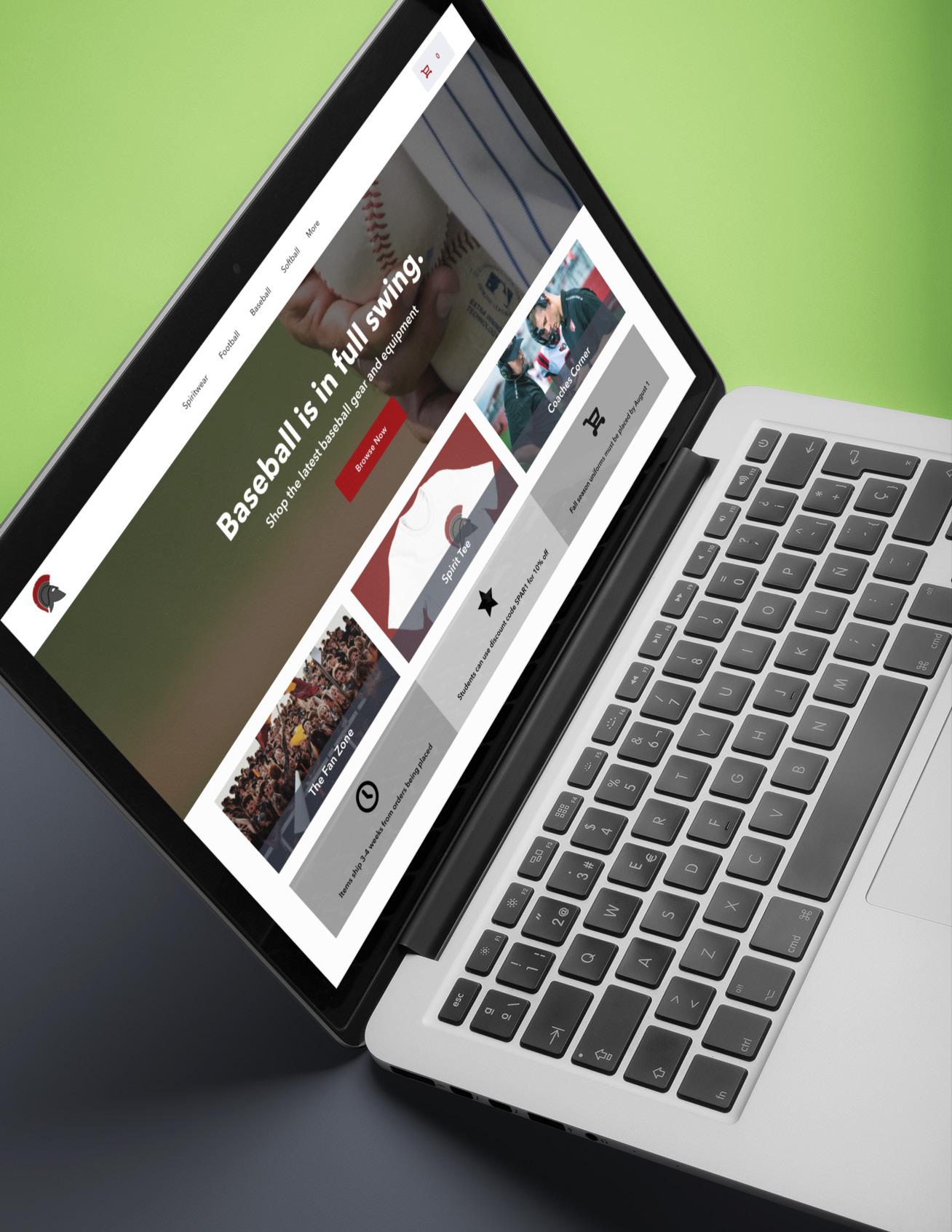


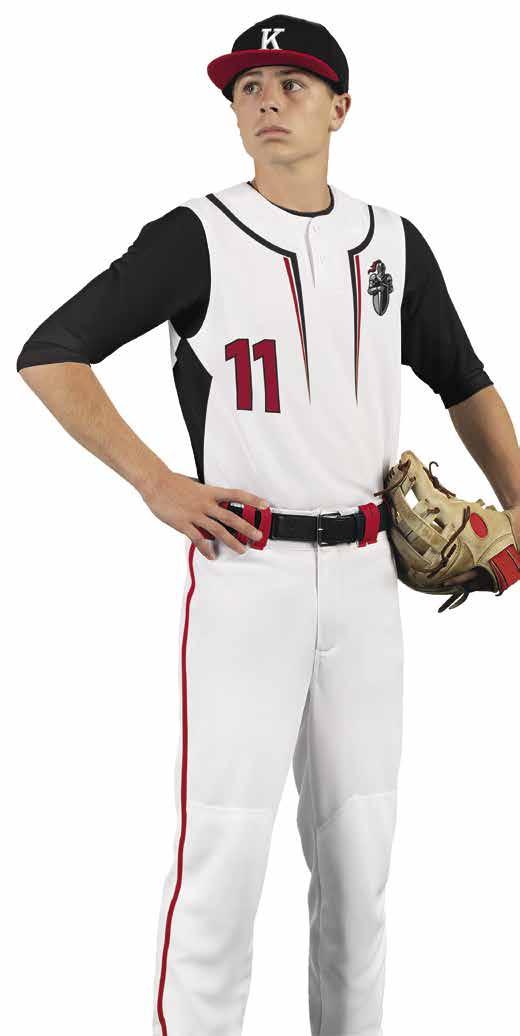





With the recent increase in interest rates and more economists anticipating an economic recession in 2023, one question that arises in our industry is “what will happen to sports participation?” Because NSGA has tracked sports participation for more than 35 years using consistent methodology throughout, we can look at the last recession (defined as 2008–2009 for purposes of this article) to gain insights into the future.
If the recession had a significant impact, we would expect to see sharp declines for the years the recession occurred (2008-2009) followed by a bounce back once the period ended. When plotted on a chart over time, the data for these years would resemble a “V” shape.
On a high level, we can use NSGA’s Total Participation Points (TPPs) metric to analyze participation among specific segments tracked by NSGA. With TPPs, one point is given for each sport a person participates in during a given year. This offers a more complete view of participation because both the number of people participating in each sport segment (reach) and the number of sports each person is participating in (depth) are considered.
Looking at the data over multiple years is also important when identifying
trends. For this analysis, we will include data from 2004-2013, giving us 4 years before and after the 2008-09 recession. As shown in Figure 1, the years during the recession were part of larger trends the segments were experiencing during this period. The changes in participation during these two years were not abnormal or out of the ordinary and for the most part follow along the dotted trendline. The fitness segment saw participation increase during both recession years, following along with the larger trend of steady participation increases during the full 10 years. The changes in participation for the individual, team and wheel segments during 2008-09 also go along with the longer-term trends of declines in participation over that decade.
BY NICK RIGITANO NSGA DIRECTOR OF INSIGHTS AND ANALYSISAs we get more granular, a similar theme takes shape for the selected sports shown in Figure 2. The recession figures for running/jogging, golf, and soccer follow the 10-year trendlines for their respective sports. The remaining sports deviate slightly during the recession years, but the changes are within the range of other non-recession years.
Based on the data, it appears the 2008-2009 recession itself did not have a significant impact on sports participation. The changes incurred during these years were part of longer-term trends and there are a variety of factors that influence changes in sports participation. Because different factors have different levels of influence for each individual participant, it is important for our industry to take a combination of them into account when developing programs and creating opportunities for involvement.
FIGURE 1
Sports Inc. CEO Todd Adams announced at the buying group’s Team Dealers Fall Show he is stepping down and would be replaced on January 1, 2023 by Travis Elam.

Adams said it was a decision to spend more time with his family and grandchildren and he will stay on in an advisory role for the first part of 2023. He has been with the Sports Inc. buying group since 2000 and took over as CEO in 2011 from Dave Salvi. He worked for 10 years as a team salesman with Universal Athletic before joining Sports Inc.
“I’m going to miss all of you and all of it,” Adams said. “It has been incredible.” Elam has been in charge of Sports Inc.’s team division and started in the outdoors division. Max Pearson will move up to become the Sports Inc. director of team sports.
“I’m honored you would ask me to take on this awesome responsibility and I’ll do everything I can to carry on what you’ve done the last 11 years,” Elam said of Adams.
Other changes in the Sports Inc., transition plan have Corry Arntzen as Vice President, Operations, Andy Eames as Vice President, Sales and Marketing, Jay Hanson as Senior Director, Outdoor Sports and Kale Schwede as Director, Outdoor Sports. Elam, Arntzen, Eames, Pearson, Hanson and Schwede have a combined 79 years of experience working for Sports Inc.

Outdoor Retailer announced a new format in its approach to serving the outdoor and winter sports marketplace. Through the introduction of new events and a shift in future dates, Outdoor Retailer will provide more opportunities for the industry to engage in the timeframes that best support the industry. The new format will be:
• January 2023: Outdoor Retailer Snow Show runs January 10–12, 2023, at the Calvin L. Rampton Salt Palace Convention Center and new Hyatt Regency Salt Lake, with the new addition of The Summit by Outdoor Retailer on-mountain experience on January 9, 2023 at Brighton Resort;
• June 2023: The Outdoor Retailer Summer national business-to-business commerce event remains in June at the Salt Palace at the front of the summer buying season, with the new Outdoor Adventure X (OAX) consumer festival staging the weekend prior at Snowbasin Resort;
• Starting November 2023: The national winter business-to-business commerce event rebrands as Outdoor Retailer Winter and moves to early November in the Salt Palace at the start of the seasonal sales cycle;
• Launching January 2024: The Summit by Outdoor Retailer expands into a new multi-day leadership conference with an immersive on-mountain winter experience, moves to late January, and aligns with Winter Sports Market, the specialty buying group trade event from Snowsports Merchandising Corporation (SMC) and Sports Specialists Ltd. (SSL).
For the next five years, 2023–2027, Outdoor Retailer events will take place in Salt Lake City and County, starting with
Snow Show on January 10–12, 2023, at the Salt Palace. Neighboring mountains and outdoor spaces will become destinations for experiential and consumer programming. Find all future dates at outdoorretailer.com.
“We’re evolving the Outdoor Retailer format and creating new, unique ways for brands to engage around their business needs and goals,” said Marisa Nicholson, Outdoor Retailer senior vice president and show director.
“These changes are based on feedback we’ve received from brands, retailers, reps and suppliers, all working on earlier product deadlines. So, we’re transforming to make sure we’re providing the most relevant platform to showcase product and do business. Outdoor Retailer Winter and Summer are now both at the beginning of the respective sales seasons and in position to support the greater buy/sell ecosystem.
“In addition, a new event, The Summit by Outdoor Retailer, will deliver elevated education and conversation. Through a renewed partnership with SMC and SSL, The Summit now aligns with Winter Sports Market to establish a more efficient industry calendar and new avenues for customer engagement. We’re excited to be expanding upon our cornerstone events, to move into the timeframes the industry needs, and to provide more meaningful opportunities for the community to connect.”
Continued on page 20
Continued from page 19
Tom Morris Award presented by the Golf Course Superintendents Association of America (GCSAA). Morris will be honored Feb. 9 at the Send-Off Celebration at the 2023 GCSAA Conference and Trade Show in Orlando, Fla.
Morris was inducted into NSGA’s Sporting Goods Industry Hall of Fame in 1998. Read his Hall of Fame biography at nsga.org/hof-inductee/johnny-morris/.
The Old Tom Morris Award is presented to an individual who, through a continuing lifetime commitment to the game of golf, has helped to mold the welfare of the game in a manner and style exemplified by Old Tom Morris. Old Tom Morris was a four-time British Open winner and the legendary greenkeeper at St. Andrews in Scotland.
“Our move to Westport Plaza reflects the tremendous growth of our baseball and softball business and allows us to create an immersive brand experience for fans and athletes alike,” said Mike Zlaket, CEO of Rawlings. “As a storied brand based in St. Louis, Rawlings has very strong ties to the local community, and it was important for us to remain here in such a renowned baseball town.”
The move coincides with significant revitalization plans taking place in Westport Plaza designed to attract new business tenants.
Within Rawlings’ expanded experiential retail space, their full assortment of baseball and softball product lines will be displayed and available for purchase as well as a wide array of customizable options across multiple product lines. Additionally, the brand will highlight historic artifacts that have been integral to its success and growth throughout the years.

OrderMyGear (OMG) acquired BrightStores, a provider of online company stores for promotional product distributors.

The partnership brings together two market-leading technology platforms in the team sporting goods and promotional products spaces. Together, the combined solutions will provide best-in-class technology designed specifically to meet the needs of promotional product distributors, apparel decorators and team dealers as they grow their business online.
Rawlings Sporting Goods Company, Inc., the official baseball, glove, helmet, face guard and base of Major League Baseball® and the creator of the iconic Rawlings Gold Glove Award®, announced it will be moving from their current corporate headquarters located in Town & Country, Missouri to Westport Plaza in Maryland Heights, Missouri in late 2023.
The decision to relocate was predicated by the need for additional office space and a desire to create a full corporate campus, including an experiential retail destination. Rawlings has been based in St. Louis since its inception in 1887 and hopes to elevate its visibility as a St. Louis-based company.
Wilson extended its well-established partnership with the National Collegiate Athletic Association® (NCAA) as the official ball of March Madness and the Final Four for both the men’s and women’s basketball championships and the National Invitation Tournament (NIT®). The extension builds on a storied relationship spanning more than two decades. Additionally, the Big Ten Men’s and Women’s basketball championships will exclusively use the Wilson NCAA Evo NXT ball for their tournament, joining other conference championships such as the SEC, PAC-12 and Big 12. Wilson’s other partnerships include the NBA and WNBA.

The addition of BrightStores enables OMG to offer a fully configurable, feature-rich online store solution to support complex, long-term use cases alongside OMG’s widely adopted online pop-up stores. With the combined expertise of OMG and BrightStores, businesses that sell custom branded merchandise and apparel to groups will have more opportunities to support a wide range of customer programs with a single platform and partner. Clients will continue to leverage the online store solutions they use to serve customers today, while also gaining access to additional online store capabilities to help them unlock new revenue opportunities.
Founded in 1999, BrightStores has focused exclusively on building technology for promotional product distributors, developing the most complete company store solution and deep industry expertise.
OrderMyGear is a longtime member of the National Sporting Goods Association and supporter of the Management Conference & Team Dealer Summit.
Continued on page 22



Continued from page 20
The National Sporting Goods Association makes an annual check with national sports governing bodies for rule changes regarding equipment and uniforms that could impact team dealers and retailers. NSGA shares what’s ahead for 2023 and beyond, starting with the potential trickle-down effect of Major League Baseball going to bigger bases next season.
BASEBALL:
BIGGER BASES A BIG QUESTION
Major League Baseball announced this summer it is increasing the size of its bases from 15 inches to 18 inches for the 2023 season. Minor League Baseball made the switch to bigger bases in 2022. Team dealers and retailers have asked NSGA if other organizations would move to bigger bases. Here’s a look at that issue and other baseball-related rule changes.
NCAA: The NCAA Baseball Rules Committee discussed a change to require larger bases at its annual meeting in July, according to the NCAA’s Ben Brownlee, who oversees baseball. The committee did not move to require that change but did move a change to permit larger bases in non-institutionally owned facilities. This eliminated the need for a waiver for colleges to play a game in a Minor League or MLB stadium. The next opportunity to review/recommend the base-size change will be in 2024.
NFHS: No changes are currently anticipated at the high school level regarding the size of the bases from the National Federation of State High School Associations (NHFS).
PONY Baseball: Rule 7H has been changed to bases shall not be smaller than a 15-inch square. This gives
leagues the option of continuing to use present-sized bases or switching to the larger MLB-sized bases.
American Legion: Executive director Steve Cloud said they did not adopt the bigger MLB bases or the pitch clock because of the cost with the implementation. “The majority of our teams play on high school fields so we can’t mandate they upgrade the facility,” Cloud said.
Babe Ruth/Cal Ripken: There are no changes for 2023 on base sizes but it will be discussed by the rules committee at its annual meeting, according to president & CEO Steve Tellefsen.
American Amateur Baseball Congress: There is no move to go to larger bases currently, according to AABC president Richard Neely.
Dixie Youth Baseball: The earliest the size of the bases will be discussed is at its national meetings in August 2023, according to DYB commissioner William Wade.
A bat which does not meet specifications will be deemed an illegal bat and the batter using the illegal bat will be called out. If a second batter is called out for using an illegal bat in the same game by the same team the team manager will be ejected.
The use of pine tar or other similar adhesive substances on a bat is prohibited and will result in the bat being declared illegal.
Dixie Boys/Majors Baseball: Rule changes are made in odd-numbered years so some are anticipated for the 2024 season.
Little League Baseball: No changes for uniforms and equipment for 2023.
USSSA: No changes for uniforms and equipment for 2023.
USA Softball: A couple of rules regarding bats and helmets were revised and take effect January 1, 2023.
Any bats bearing the USA Softball, USSSA, or WBSC Certification mark and passes the USA Softball Fast Pitch Compression test thresholds will be allowed in the USA Softball Men’s Major and Men’s Open Fast Pitch Championships. This would allow players to use WBSCapproved bats they currently use in their Federation.

Any defensive or offensive player may wear a helmet at any time. In fast pitch, helmets shall have a non-glare (not mirror-like) surface. This allows helmets with a reflective or mirror-like finish to be used in slow-pitch softball.
PONY Girls Softball: At the Shetland Level, bats marked T-ball are not allowed when using a regulation 11-inch softball.
USA Wrestling: The use of protective headgear of the type required for scholastic wrestling is authorized and recommended in the Junior level and below. Headgear is allowed in U20, Masters, Senior and U23 competition. It is no longer required that headgear be removed in the United World Wrestling age divisions at the request of the opponent. In any division, a face mask is allowed only to protect an existing injury, or an injury occurring during the bout, and must be prescribed by a medical doctor or the event’s chief medical officer.
Our biggest concern, and I believe of the entire country, is the economy. Coming out of a tough 2020 with hockey and all activities being limited or not played at all put a strain on the business world. 2021 was good but again limited at different times. The 2022 season started very strong with lots of people coming back to skating, but as we are coming to the end of the year you can see purchasing patterns change. It does not help that prices across the board have risen at higher percentage rates than we have seen in years. Hopefully we will see a slowdown in price increases and a more stable marketplace.
My father grew up playing hockey, which eventually landed him at Bowling Green University. From the time my sister and I could walk he had us in skates. We started skating in Indianapolis where the ice rink was an hour from our house. My dad was transferred for work to Columbia, Maryland in 1978 and when we moved the first thing he did was drive us all to the local rink which was 5 minutes from our house. From that point I grew up playing hockey for the local association, Howard County Youth Hockey, now the Howard Huskies. As I moved from youth hockey to beer league, I met Phil Howe, who was the national sales director for Mission Hockey, which was the leader in roller hockey and was trying to get into the ice game. Phil hired me to work for Mission which was a great learning experience. I had been there for around 3 years when I had an opportunity to open my own store at the Garden’s Ice House in Laurel. My father was the managing partner of the 3-sheet rink. They already had two shops that had not made it for different reasons, so in August 2003, I resigned from Mission and opened our first location.

What I enjoy the most is getting the first-time hockey player outfitted with equipment. We have a lot of little kids who are just getting started and when they come in to pick up their gear the smile they have on their face is awesome. We also do a ton of fittings with adult players just getting started. They are sometimes more fun to work with than the kids. I also enjoy the opportunity to be part of the local hockey community. Having grown up playing in Maryland and seeing how much the sport has grown over the years is great.
Having a network of other stores you can talk to about what is going on in their area is a big benefit. Having a group of stores from all over the US gives you an opportunity to see what trends are working in other parts of the country. It also helps when you are looking for something/inventory and you can reach out to other stores.

What separates our stores versus the other hockey stores is our staff. The people who work for us are local hockey people who grew up playing in the area. My wife and I also work at our stores every day, so people know us and appreciate the service we provide. We have a hands-on approach with our customers.

“I love speed networking. It’s a fantastic way for us to tell our story, from a technology perspective, in a short period to the masses.”
Matt Kaplan, President, OrderMyGear“(The conference) provides an opportunity to do a lot of networking and really gain insights into things that are happening in the industry.”

 John Scipio, CEO, SV Sports
John Scipio, CEO, SV Sports
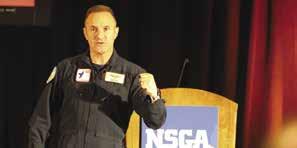
“As an owner of a business, I’m coming back with connections. Connections might be with another dealer who has the same issues and problems or maybe the same solutions.”
 Mike Blythe, Owner, Blythe’s Sporting Goods
Mike Blythe, Owner, Blythe’s Sporting Goods
